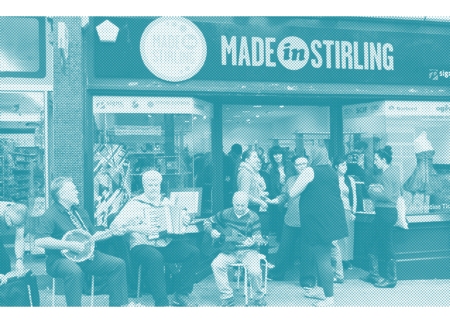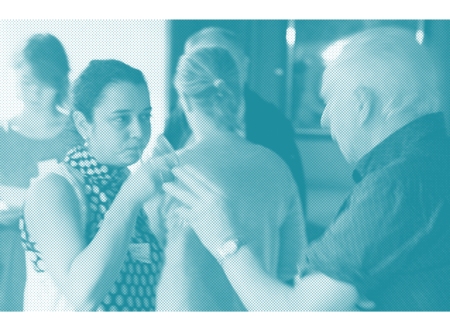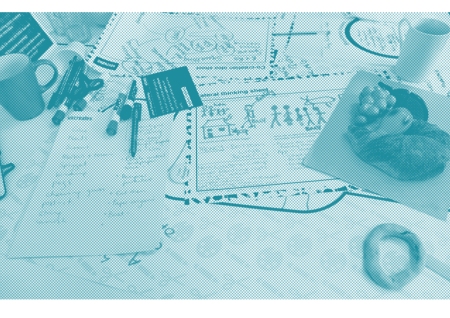FOUR EXEMPLARY SOCIAL DESIGN CASE STUDIES
START UP STREET STIRLING
A PROJECT BY: SNOOK (www.wearesnook.com)
What the project is about:
Snook filled an empty shop in stirling and revitalised the high street. “Our high streets make a unique contribution to local neighbourhoods and economies and right now they are in crisis with nearly a third of UK high streets degenerating or failing” (snook, http://wearesnook.com/snook/?case=start- up-stirling). The challenge is to re-think our high streets as public spaces where people want to be, not simply for commerce, but somewhere to work, play and learn.
A+DS and Stirling City Council commissioned Snook to
help make this happen in Stirling. The aim of this project is to explore how people with ideas, talents and capabilities in the city can be matched with the available spaces in the city, where they can find the support of an interested community.
The output of this work is an initiative called Start Up Street Stirling. Snook have delivered a blueprint that encompasses not only the opening of the shop but how SUS can support and train members of the public to test out their business ideas inside high street shop units for a short period of time.
RELATIVE FRIENDS
A PROJECT BY: thinkpublic (www.thinkpublic.com)
What the project is about:
Building on thinkpublic user insights together with published research from the Campaign on Loneliness, the Centre for Intergenerational Practice and others, shows that there is a growing ‘epidemic’ of loneliness across the UK, with associated problems around loss of identity and poor mental health. This is driven by changes to social structures, work environments and family and is exacerbated by generations becoming more disconnected from each other, with many people lacking both connection within the family but also those natural connections across the generations that promote mutual support and exchange.
‘’We have developed Relative Friends as a new social venture that helps people build family-like relationships with people in their local area. The service combines hosted social events, meetups and shared activities, with a safe online social networking environment, which together enable a range of isolated and lonely people to build caring and supportive friendships with people who live or work nearby. Our objective is to create meaningful intergenerational relationships with the support and exchange that family close by might provide, promoting engagement, empowerment and happiness’’ (thinkpublic, http://thinkpublic.com/case-studies/ relative-friends).
BOOST PRODUCTIVITY: HEALTHIER EATING AT WORK
A PROJECT BY: uscreates (www.uscreates.com)
What the Project is about:
The project’s goal is to facilitate healthier eating at work to impact productivity and create a happier and healthier team. Through Staff interviews, roundtables and insight probes the Team identified barriers to change: a lack of inspiration and healthy food sources nearby.
Uscreates innovative solutions to encourage behaviour change involved an honesty fruit bowl system, visiting chef, health lunch pack delivery service, health and nutrition MOTs and staffroom re-design. One year on 23% of employees rated their lunch healthier, and 73% are eating at least two portions of fruit/vegetables at work per day.
HISTORYPIN
A PROJECT BY: WeAreWhatWeDo (www.wearewhatwedo.org)
What the project is about:
Historypin was born out of our research into the state of intergenerational relationships, particularly in the UK and USA. Using a body of existing work and taking on our own consul- tation and research, the depth and importance of the divide across older and younger generations became very clear.
Exploring the lack of contact and negative perceptions that have become gradually ingrained since the 1960s, we could map this with our ongoing analysis of changing patterns in the social capital, to find similar forces at work: disintegration of associational life in many communities was pulling older and younger generations apart, just as it was reducing many other indicators of healthy community life.
Historypin is a way for millions of people to come together, from across different generations, cultures and places, to share small glimpses of the past and to build up the huge story of human history. Everyone has history to share: whether its sitting in yellowed albums in the attic, collected in piles of crackly tapes, conserved in the 1000s of archives all over the world or passed down in memories and old stories. Each of these pieces of history finds a home on Historypin, where everyone has the chance to see it, add to it, learn from it, debate it and use it to build up a more complete understanding of the world.
ASKING QUESTION: MARJETICA POTRČ
Marjetica Potrč is an artist and architect who works on community-based projects characterized by participatory design and a concern for sustainability. Her work emphasizes individual empowerment, problem-solving tools, and strategies to create self-sustaining prosperity within these communities.
1.WHAT IS SOCIAL DESIGN?
Social design is socially engaged design. It addresses social needs, and it aims to improve lives of communities by creating together with them a project which stands for new culture of living. In difference with culture of consumerism, which is fast, global and unpolitical, new culture of living is long-term, local and political. Social design is based on participation of communities in design process. It is achieved by working with and sharing knowledge with local residents. The project stays in the community and benefits the community over the long term.
Participatory practice proceeds through the following steps:
1. Listening to and talking with residents before making a definite plan.
2. Involving the community in the decision-making and design processes.
3. Involving the community in the construction process.
4. Transferring the responsibility for the developed project to the community in order to leave behind a sustainable work that benefits the community in the long term.
2. WHAT ARE MANNERS OF SOCIAL DESIGN?
Long-term, local and political.
3. WHY SOCIAL DESIGN?
One of the reasons is that while we experience continuous growing of cities – by 2050, 7 out of 10 people will live in city, at the same time cities find themselves in the process of shrinking towards neighborhoods. If 20th century’s imaginary was globalization, metropolis and top-down design, today we talk about organization of cities on local level. Participatory projects are being acknowledged by authorities, who used to think and act top-down and large scale. The challenge is to understand how these small-scale projects which are organized locally, work on a large-scale, on a level of a city. How is it possible to put particles to- gether? How can participatory projects be activated on a larger, legislative scale? Another fact is decline of public space, as the idea of public space being free and accessible to all does not hold in many ways – due to privatization of public space, but also due to growing divide between poor and rich urban population. To live in a city today means reconfiguring roles of actors. Social design engages local communities
in participatory projects, which are used by communities as tools for changing their culture of living. They are catalysts of change. They are also political schoolrooms where residents reclaim their city by getting organized on level of neighborhoods, from where they aim to shape the city they aspire to live in. You can say that when you are engaged in participatory design you experience a bottom-up process that aims to reconstruct the world.
4. PERSPECTIVES ON SOCIAL DESIGNERS
Social design creates new paradigms in how things are done and how society is organized. Although participatory project multiply quickly they remain small but crucial laboratories of human coexistence where practices and ideas are tested, appropriated and developed further.
ASKING QUESTION: RICHARD SAXTON
http://www.m12studio.org and http://www.ruralexperiences.org
1.WHAT IS SOCIAL DESIGN?
For me this term simply means designing for social space. I don‘t directly identify with this term as an attachment point for my working method, I believe as a term „Social Design“ is describing and perhaps even encouraging those in the design fields to focus on putting their ideas and skills to use in the larger social sphere. This includes both public and private spaces that have a central social function.
2. WHAT ARE MANNERS OF SOCIAL DESIGN?
I interpret ‚habits“ as process. For me this process (again not specifically labeled Social Design), begins with a community perspective. As artists and designers we take the „habits“ of those we are working with as the nucleus for our projects. We start the design process through social interactions. Coffee, eating together around a table, taking a walk together – these activities become very important starting points for the work. From here everything radiates, for without these activities our designs are empty. Each project is different, being responsive to the social conditions on the ground and the physical environment, but even before thinking about what the design will be, what we will build, what we will make, we have to sit together in social spaces.
2. WHAT ARE THE GAPS AND CHALLENGES OF SOCIAL DESIGN?
The biggest challenge to this working method is Capitalism. When we work against a system that values only the individual and the most profit, we work against our process (Social Design, Social Sculpture / Social Architecture). In order for projects to succeed they must be collaborative -they must view the maker (designer) and the client (community) on a level playing field. There is not a hierarchy in place where the designer tells the designed what to do or how to be. In Social Practice we work together as partners from the beginning to the end. This is why the capitalist model is always working against our work -we do not wish for one person or perspective to rein over another or to profit over another. Our work is connective, meaning it aims to connect people, place, and mediums together through the moments of a given project.
3. WHY SOCIAL DESIGN?
Our work provides an avenue for democracy (specifically regarding the urban/rural continuum). When we work in a way that values communities and the perspectives of non- artists and non-architects we are providing paths to creative living and enriching spaces. By working this way we don‘t ask a building or a space to be the same in 20, 50, 100 years from now as it is today. We work in this moment with people who are living now. We celebrate our differences through
the process of this work and we work towards a high level of consensus, providing space for the ideas and lives of many people. It is important that art, design, architecture not continue on a path where the „majority“ are those with the means to be included in a cultural elite, or only those in large met- ropolitan areas. We ask for you to look at everyday spaces, rural spaces, and small communities and social groups for powerful design inspiration.
4. PERSPECTIVES ON SOCIAL DESIGNERS
As artists we value the collective over the individual, in process, voice, and production. This working method works against the „cult of personality“ so prevalent in creative fields – It also works against the idea that bigger is better. This practice is built around one of mutual respect and the value of the neighbor. We value history and tradition but also push for new collaborative potentials to emerge. We have a connective lens attached to our work, meaning we are always looking for threads that tie us together -whether that is in a physical space or a personal or communal space. The objects of design therefore are also connective, they do not exist on islands, there are always points of connection for the object (or building, space, action, etc) to tether itself to. For us this is simply how most of the living world works – through a process of biological dispersal. We gather, collect, magnetize, generate and then spread into our various living spaces. Our lives are then reflected as moments in these processes and experiences
WRITTEN BY JULIA ANNA SUWALSKI



